A CFD Modelling Approach for the Operation Analysis of an Exhaust Backpressure Valve Used in a Euro 6 Diesel Engine
Abstract
:1. Introduction
2. Experimental Installation and Methodology
3. Model Description
3.1. Back Pressure Valve
3.2. Turbulence Model
4. Results and Discussion
4.1. Test Results
4.1.1. Engine Operating Conditions
4.1.2. Valve Closing
4.2. Model Results
5. Conclusions
- The negative effect that the closure of the backpressure valve has on the instantaneous in-cylinder pressure was observed. Assuming no effect on the average pressure inside the cylinder with full opening, a reduction in the in-cylinder pressure was measured between 1.3% and 3.9% for valve closures between 50% and 80%, respectively, for medium–high load levels.
- It was observed that with an increase in the closure of the pressure relief valve, the effective average pressure of the engine decreases between 0.07 and 1.06 bar for valve closures between 50% and 80%, respectively, for medium–high load levels. However, for that range of valve closures, increases in the temperature of the exhaust gases upstream of the valve are observed between 5.7 and 11.7 °C.
- The development of this work has made possible to propose a CFD model. With this model, the flow around the valve was simulated under different temperatures and the mass flows of exhaust gas and different closing positions of the backpressure valve. For all cases, pressure drop values were obtained. The level of agreement between the results obtained by the model compared to experimental measurements is around 91%.
- The developed model helped to propose a correlation to estimate the mass flow rate of exhaust gas from easily measurable quantities on a test bench, such as gas temperature, valve closing angle, and pressure drop.
- A positive deviation of around 5 degrees of backpressure valve closing was obtained between the modelled angle and the experimental angle for all engine operating conditions and all valve closing angles.
Author Contributions
Funding
Data Availability Statement
Acknowledgments
Conflicts of Interest
Abbreviations
| C | constant |
| G | generation |
| k | turbulence kinetic energy |
| mass flow rate | |
| p | pressure |
| t | time |
| T | temperature |
| u | velocity |
| x | direction |
| fluctuating dilatation | |
| inverse Prandtl number | |
| rate of dissipation | |
| dynamic viscosity | |
| density | |
| Subscripts | |
| buoyancy | |
| rate of dissipation | |
| i | index |
| j | index |
| k | turbulence kinetic energy |
| upstream | |
| Acronyms | |
| Brake Mean Effective Pressure | |
| Computational Fluid Dynamic | |
| Direct Numerical Simulation | |
| Electronic Control Unit | |
| Exhaust Gas Recirculation | |
| Large Eddy Simulation | |
| Proportional Integral Derivative | |
| Reynolds Averaged Navier–Stokes | |
| Re-Normalization Group |
References
- Jovaj, M.S. Motores de Automóvil; Editorial MIR: Moscow, Russia, 1982. [Google Scholar]
- Heywood, J.B. Internal Combustion Engine Fundamentals; McGraw-Hill Education: New York, NY, USA, 2018. [Google Scholar]
- Payri González, F.; Desantes Fernández, J.M. Motores de Combustión Interna Alternativos; Editorial Universitat Politécnica de Valencia: Valencia, Spain, 2011. [Google Scholar]
- Luján, J.M.; Guardiola, C.; Pla, B.; Reig, A. Switching strategy between HP (high pressure)-and LPEGR (low pressure exhaust gas recirculation) systems for reduced fuel consumption and emissions. Energy 2015, 90, 1790–1798. [Google Scholar] [CrossRef]
- Choe, M.; Park, C.; Choi, D. Flow analysis on formation of back-pressure in exhaust system applying electronic-variable valve. Indian J. Sci. Technol. 2015, 8, 21. [Google Scholar] [CrossRef]
- Pan, X.; Wang, G.; Lu, Z. Flow field simulation and a flow model of servo-valve spool valve orifice. Energy Convers. Manag. 2011, 52, 3249–3256. [Google Scholar] [CrossRef]
- Long, C.; Guan, J. A method for determining valve coefficient and resistance coefficient for predicting gas flowrate. Exp. Therm. Fluid Sci. 2011, 35, 1162–1168. [Google Scholar] [CrossRef]
- Gülmez, Y.; Özmen, G. Effect of exhaust backpressure on performance of a diesel engine: Neural network based sensitivity analysis. Int. J. Automot. Technol. 2022, 23, 215–223. [Google Scholar] [CrossRef]
- Fernández-Yáñez, P.; Romero, V.; Armas, O.; Cerretti, G. Thermal management of thermoelectric generators for waste energy recovery. Appl. Therm. Eng. 2021, 196, 117291. [Google Scholar] [CrossRef]
- Ezzitouni, S.; Fernández-Yáñez, P.; Sánchez, L.; Armas, O.; Soto, F. Effect of the use of a thermoelectric generator on the pumping work of a diesel engine. Int. J. Engine Res. 2021, 22, 1016–1027. [Google Scholar] [CrossRef]
- Tuncer, C. Analysis of Turbulent Flows; Elsevier: Amsterdam, The Netherlands, 2004. [Google Scholar]
- Reveillon, J.; Péra, C.; Bouali, Z. Examples of the potential of DNS for the understanding of reactive multiphase flows. Int. J. Spray Combust. Dyn. 2011, 3, 63–92. [Google Scholar] [CrossRef]
- Piomelli, U. Large-eddy simulation: Achievements and challenges. Prog. Aerosp. Sci. 1999, 35, 335–362. [Google Scholar] [CrossRef]
- De Villiers, E. The Potential of Large Eddy Simulation for the Modeling of Wall Bounded Flows; Imperial College of Science, Technology and Medicine: London, UK, 2006. [Google Scholar]
- Versteeg, H.K.; Malalasekera, W. An Introduction to Computational Fluid Dynamics: The Finite Volume Method; Pearson Education: London, UK, 2007. [Google Scholar]
- Kang, C.W.; Yi, C.S.; Jang, S.M.; Lee, C.W. A Study of the Measurement of the Flow Coefficient Cv of a Ball Valve for Instrumentation. J. Korean Soc. Manuf. Process. Eng. 2019, 18, 103–108. [Google Scholar] [CrossRef]
- Laouar, S.; Sakib, M.N.; Al, S.M.; Navasardyan, M.V.; Kutsenko, K.V. Pressure drop in valve for different open flow areas. Proc. J. Phys. Conf. Ser. Iop Publ. 2020, 1439, 012009. [Google Scholar] [CrossRef]
- Valdés, J.R.; Rodríguez, J.M.; Saumell, J.; Pütz, T. A methodology for the parametric modelling of the flow coefficients and flow rate in hydraulic valves. Energy Convers. Manag. 2014, 88, 598–611. [Google Scholar] [CrossRef]
- Lisowski, E.; Filo, G. Analysis of a proportional control valve flow coefficient with the usage of a CFD method. Flow Meas. Instrum. 2017, 53, 269–278. [Google Scholar] [CrossRef]
- Orszag, S.A.; Yakhot, V.; Flannery, W.S.; Boysan, F.; Choudhury, D.; Maruzewski, J.; Patel, B. Renormalization Group Modeling and Turbulence Simulations. In Proceedings of the International Conference on Near-Wall Turbulent Flows, Tempe, AZ, USA, 15–17 March 1993. [Google Scholar]
- Lapuerta, M.; Armas, O.; Hernández, J. Diagnosis of DI Diesel combustion from in-cylinder pressure signal by estimation of mean thermodynamic properties of the gas. Appl. Therm. Eng. 1999, 19, 513–529. [Google Scholar] [CrossRef]
- Ma, Z.; Zhang, K.; Xiang, H.; Gu, J.; Yang, M.; Deng, K. Experimental study on influence of high exhaust backpressure on diesel engine performance via energy and exergy analysis. Energy 2023, 263, 125788. [Google Scholar] [CrossRef]

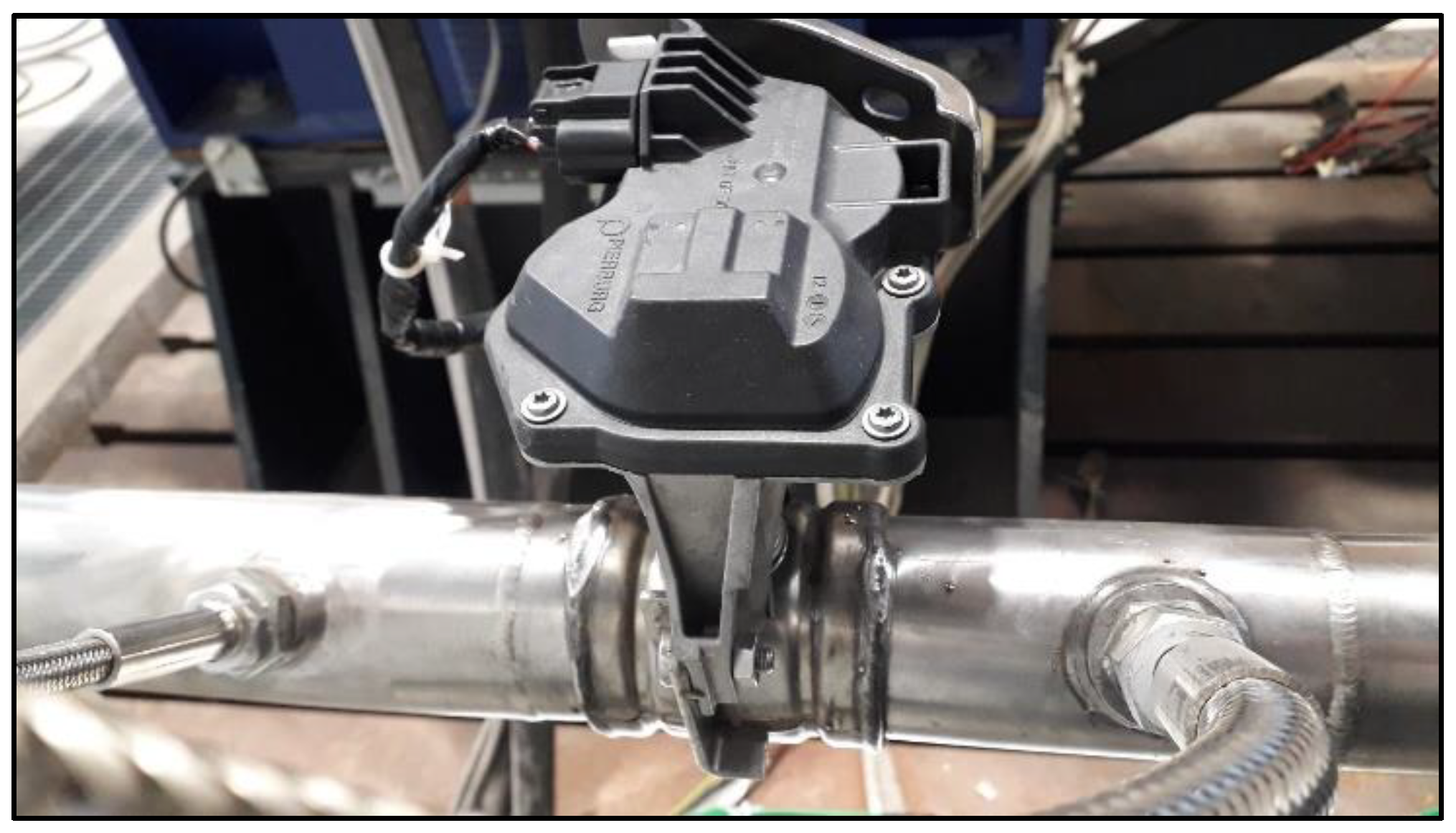



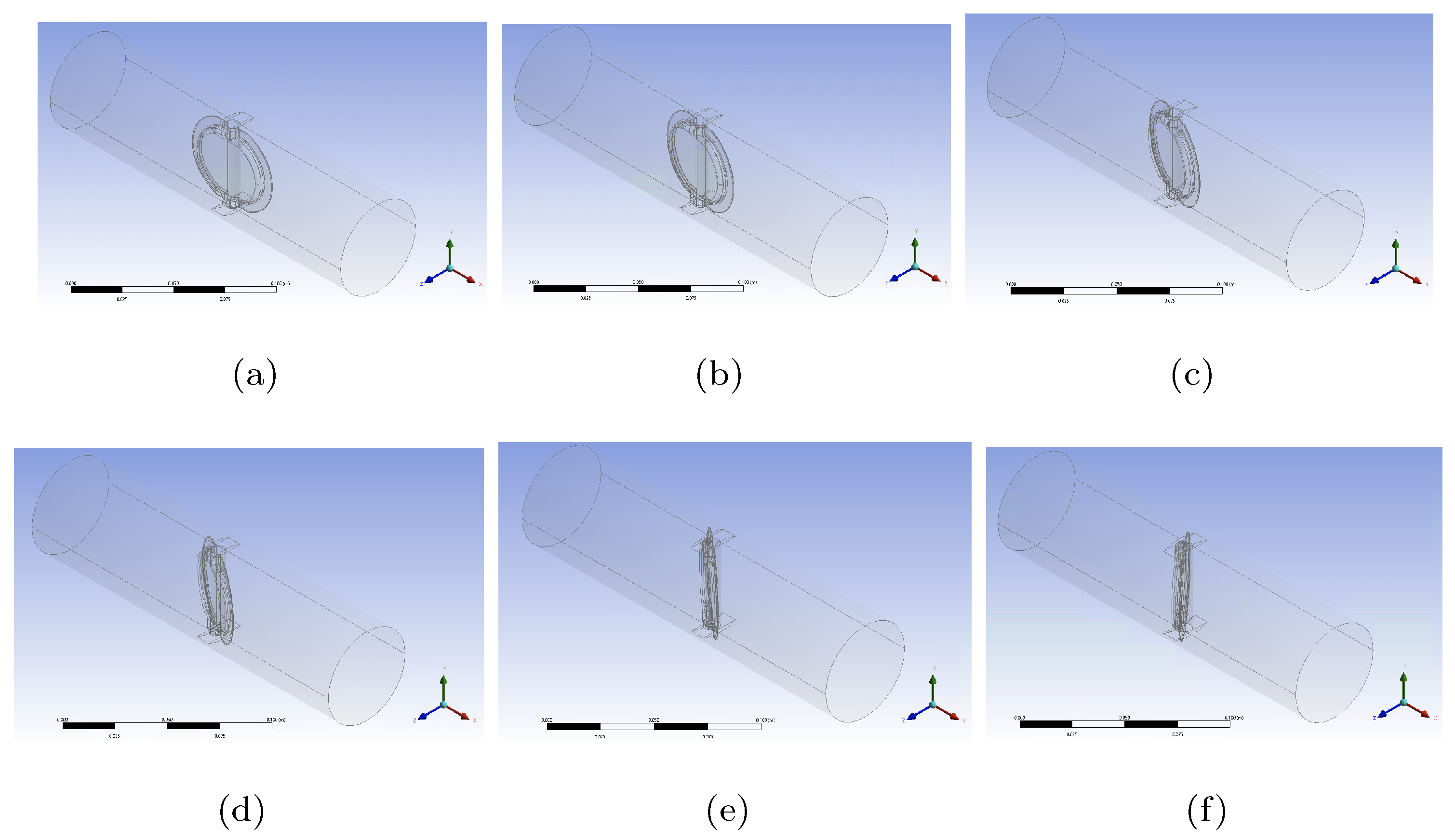

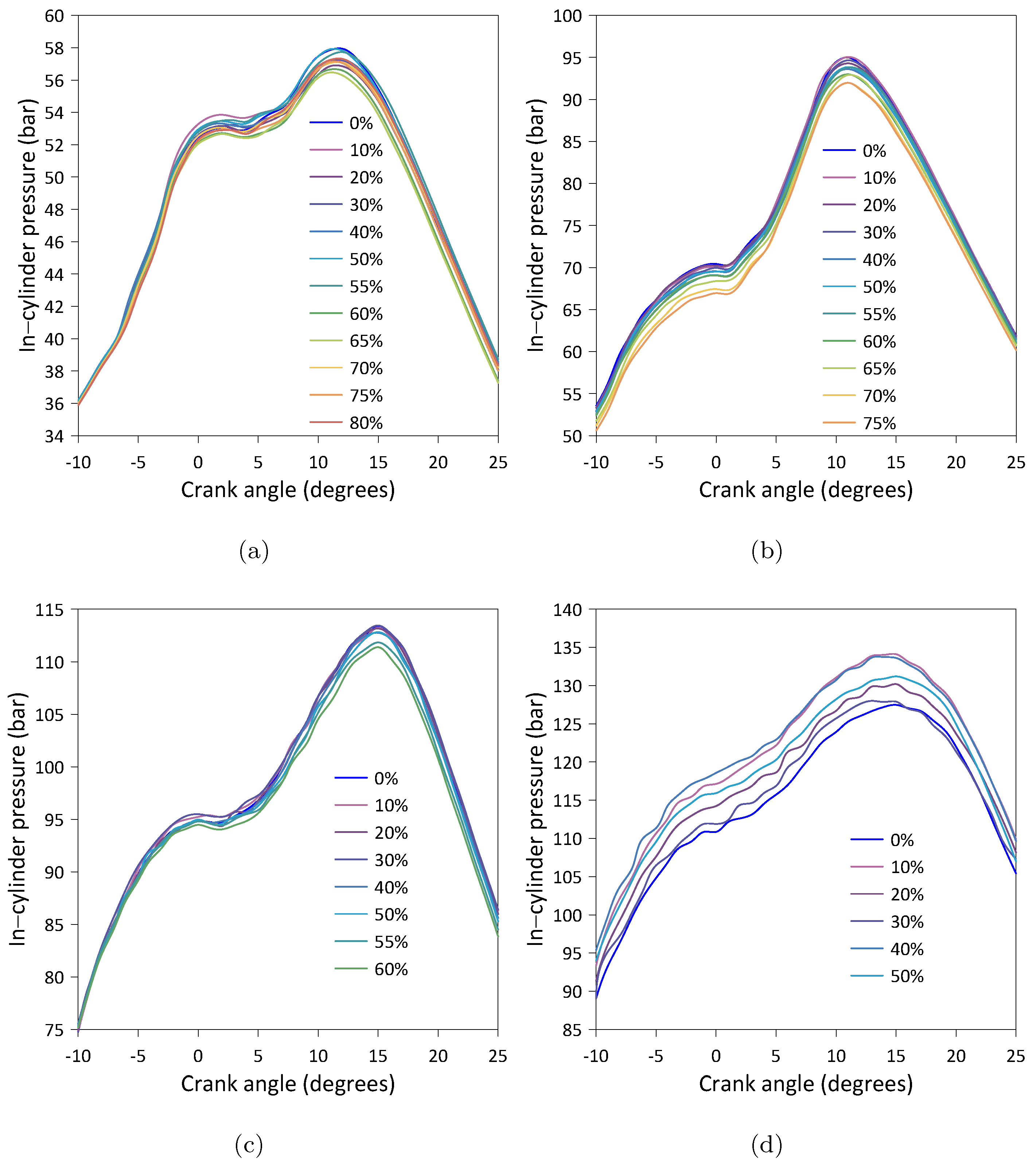
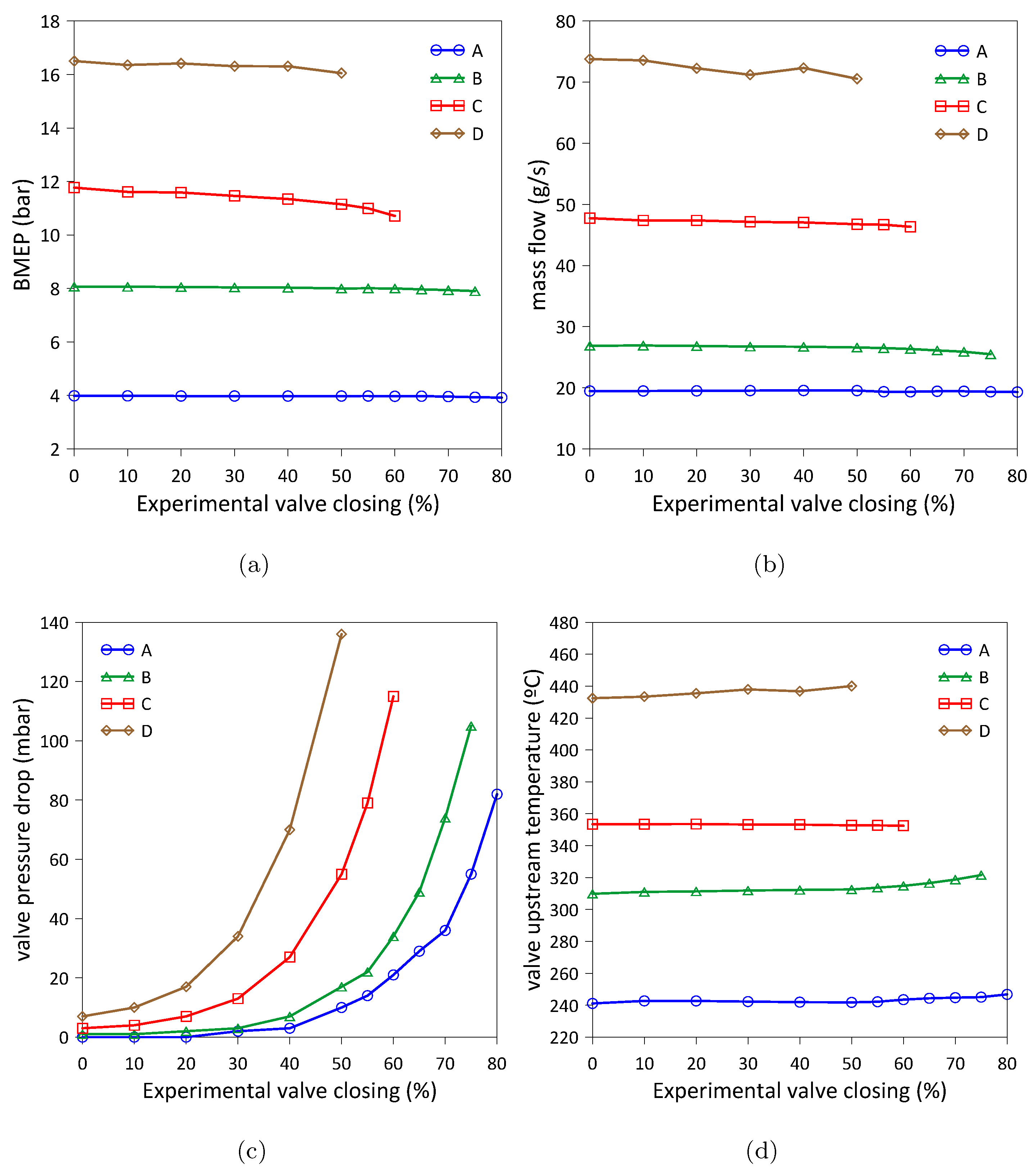


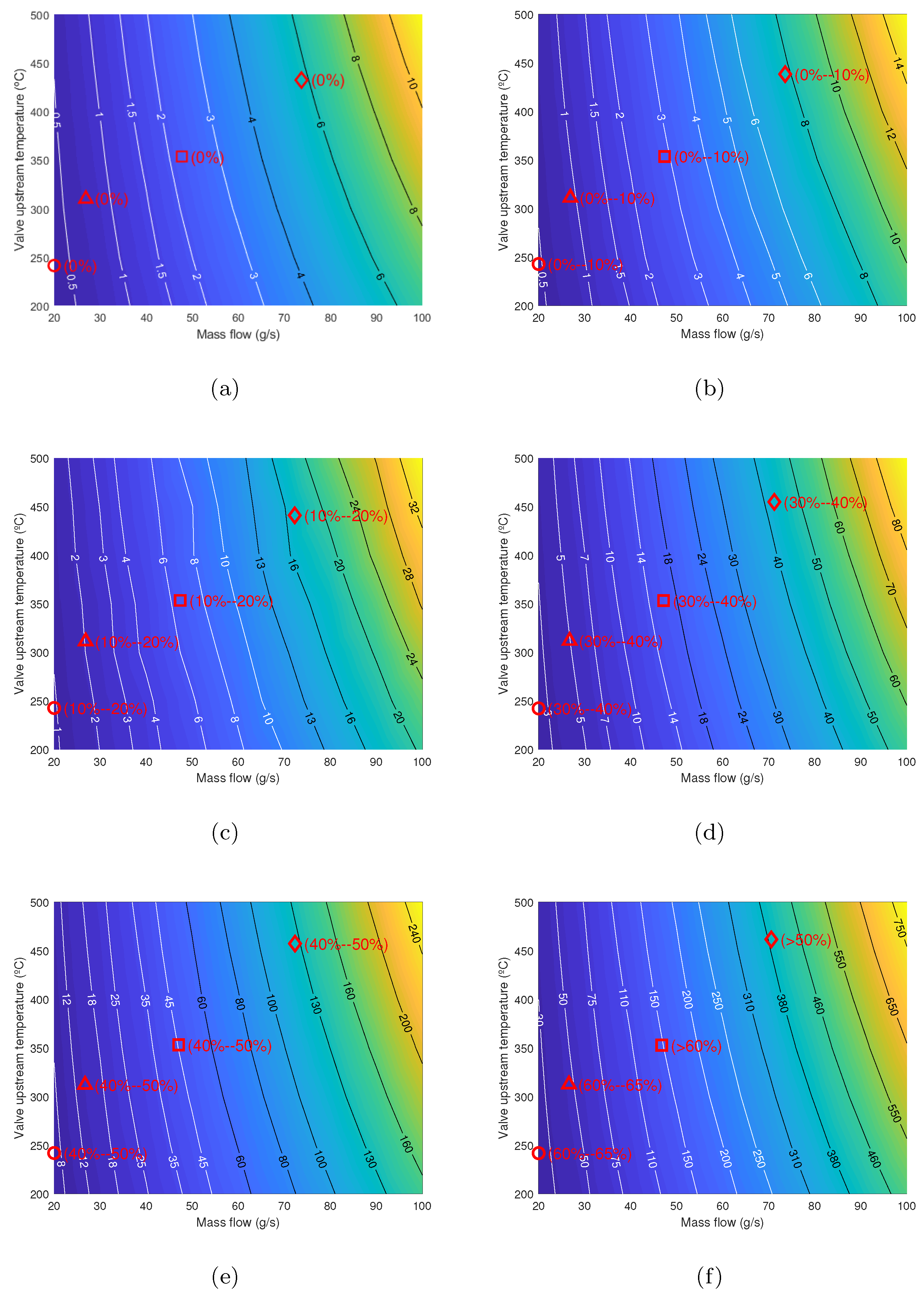
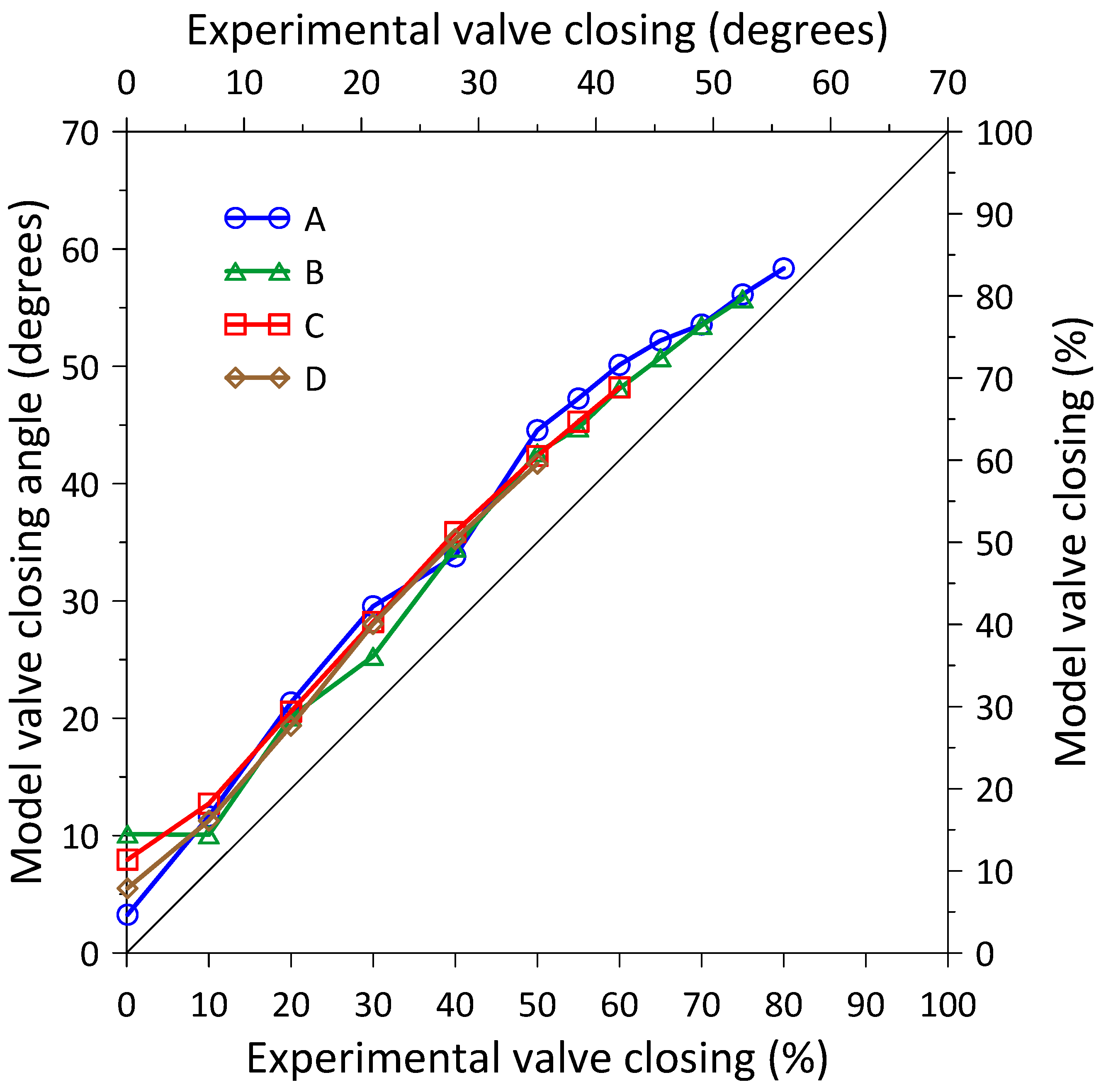
| Operating Mode: | A | B | C | D |
|---|---|---|---|---|
| Symbol in Figures | ◯ | △ | □ | ♢ |
| Engine speed (min) | 1500 | 1500 | 2000 | 2500 |
| Torque (Nm) | 50 | 100 | 150 | 200 |
| BMEP (bar) | 3.98 | 8.07 | 11.77 | 16.50 |
| (g/s) | 19.47 | 26.88 | 47.75 | 73.78 |
| (°C) | 241.12 | 309.83 | 353.46 | 432.42 |
| (mbar) | 3.38 | 6.15 | 22.50 | 52.81 |
Disclaimer/Publisher’s Note: The statements, opinions and data contained in all publications are solely those of the individual author(s) and contributor(s) and not of MDPI and/or the editor(s). MDPI and/or the editor(s) disclaim responsibility for any injury to people or property resulting from any ideas, methods, instructions or products referred to in the content. |
© 2023 by the authors. Licensee MDPI, Basel, Switzerland. This article is an open access article distributed under the terms and conditions of the Creative Commons Attribution (CC BY) license (https://creativecommons.org/licenses/by/4.0/).
Share and Cite
Martos, F.J.; Soriano, J.A.; Braic, A.; Fernández-Yáñez, P.; Armas, O. A CFD Modelling Approach for the Operation Analysis of an Exhaust Backpressure Valve Used in a Euro 6 Diesel Engine. Energies 2023, 16, 4112. https://doi.org/10.3390/en16104112
Martos FJ, Soriano JA, Braic A, Fernández-Yáñez P, Armas O. A CFD Modelling Approach for the Operation Analysis of an Exhaust Backpressure Valve Used in a Euro 6 Diesel Engine. Energies. 2023; 16(10):4112. https://doi.org/10.3390/en16104112
Chicago/Turabian StyleMartos, Francisco J., José A. Soriano, Andrei Braic, Pablo Fernández-Yáñez, and Octavio Armas. 2023. "A CFD Modelling Approach for the Operation Analysis of an Exhaust Backpressure Valve Used in a Euro 6 Diesel Engine" Energies 16, no. 10: 4112. https://doi.org/10.3390/en16104112






